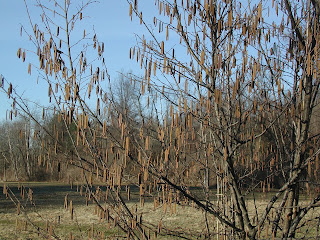temperatures.
Who gets moved, and when, depends on the plant and the weather. Broccoli, kale, cabbage, and collard seedlings are cold-hardy and almost big enough to transplant. So they’ve been sitting on the table outside the greenhouse since earlier this month. The same goes for celery, artichoke, lettuce, and onion seedlings.
Inside the greenhouse, pepper seedlings are growing in cells and tomato seedlings are almost ready to lift out of their furrows in seedling flats for re-planting in individual cells. The tomato seedlings sprout and grow fast, so even though they were sown later, they’ll soon outstrip the peppers in growth.
A wrench is thrown into this orderly march of plants within and then outside the greenhouse whenever temperatures drop near or below freezing. Then everything gets hustled back into the greenhouse, which becomes overcrowded with cell packs lining up in paths, benches, and any unplanted space in beds.
Odds are that temperatures will plummet, and more than once, before warm weather settles in for good. The average date for the last killing frost around here is the middle of May.
For the last few years, that date has been pushed way back into early April – almost. “Almost” because every year for the past few years it’s been warm, warm, warm through April and then bam!, one or two nights in early May get downright frigid, as if to remind me about that average date of the last killing frost. Those evenings I run around throwing blankets over seedlings already planted in the garden and moving seedlings back into the greenhouse. And then it gets warm again, and stays that way.
-------------------------------------------
I’m realizing earlier this year than most years that I’ve started too many flower transplants. Usually that realization comes as I’m frantically looking around the yard trying to find a home for the plants in a tray of seedlings I’m carrying around.
The genesis of this problem is not hard to fathom. Pictures of colorful flowers, oozing forth from seed catalogs that arrive against the achromatic backdrop of late winter, make purchasing seeds irresistible. Each packet has so many seeds; why not plant them all? And then prick all the seedlings that sprout, or a good portion of them, into individual cells filled with potting soil? And then . . . and then, where to plant them?
It’s too early for that final dilemma. All I know is that I now have 40 carnation plants and almost that many each of Lemon Gem marigolds and three different colors of zinnia waiting to sprout. Oh yeh, also some heliotrope, nicotiana, and delphiniums. And I am going to throw some alyssum seed right out in the garden. And I have some butterfly weed and hollyhock plants from last year’s excess that never got planted. And . . .
------------------------------------------
Sometimes I wonder just what “gardening” is. Sowing seeds is definitely gardening, as is transplanting seedlings, making compost, weeding, spreading compost, and pruning. But how about replacing the wood panels of my garden cart, something I should do now and will have to do soon? Or sharpening my grafting knife, also to be done soon, very soon? Or re-building my garden fence, something I am now in the throes of? Or sharpening and trying to start my chainsaw for cutting posts that will hold up that garden fence? It’s a busy time of year.
-------------------------------------------
Last week I wrote about looking for the small bulbs I had planted to naturalize in my lawn about 5 years ago. I feared they had petered out. Not so! They all appeared this week (except for the dwarf irises and crocuses marking my old dog’s grave). Cornelian cherry also finally bloomed, for some reason almost a month later than usual.












